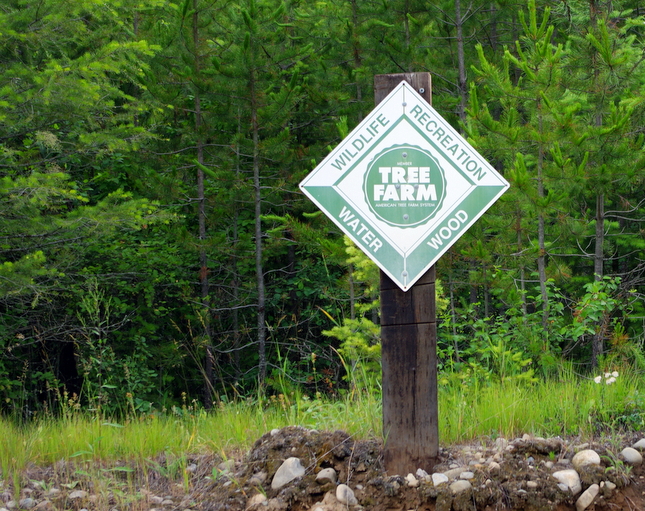Watch for the ‘big green sign’: Tree Farm System program serves many purposes

This is the tree farm of Tom and Kay Johnson, located near Republic. The farm has been select-cut twice, but it’s also managed for wildlife. (Photo courtesy of Tom and Kay Johnson)
MARQUETTE — The sign says “wildlife, recreation, water and wood” — four things you won’t see in every parcel of land that people call a farm.
In this case, the signs indicate property in Michigan’s Tree Farm System through the Michigan Forest Association.
The Tree Farm System provides a certification and recognition of forestland owners, said Matt Watkeys, certified forester for the Marquette County and Alger conservation districts.
The wood, he said, is certified as being sustainably grown.
“It kind of opens up more markets for some

This is the tree farm of Tom and Kay Johnson, located near Republic. The farm has been select-cut twice, but it’s also managed for wildlife. (Photo courtesy of Tom and Kay Johnson)
Recognition is part of the process.
Watkeys said the landowners involved in the program can place the large Tree Farm signs on their properties to showcase to their neighbors they are using professionals with their logging or harvesting efforts.
“Also, they are managing their land in a sustainable and environmentally friendly way,” Watkeys said.
Watkeys has worked with over 800 customers over the past several years, with about a quarter of those customers having enrolled tree farms.
He estimated there are 200 tree farmers in Marquette and Alger counties, with about 200 more in Delta County.

This sign indicates a property is part of the Michigan Tree Farm System. Tree farms promote forest sustainability and habitat for wildlife. (Photo courtesy of Matt Watkeys)
Details about the Tree Farm System can be found in the Marquette County Conservation District’s annual report.
It lists these bullet points:
≤ Tree Farm System connects farmers to professional foresters, other landowners and local schools. They can connect with other tree farmers to see how they manage their forest at Tree Farm field days.
≤ Landowners and foresters keep informed through magazines, webinars, conferences and websites. Tree farmers get a visit from a forester in their woods at least once every five years.
≤ The Tree Farm System helps people advocate locally and in Washington, D.C., for reasonable policies and beneficial government programs for forest owners.
≤ Tree farmers post the “big green sign” to brag about the wood, water, recreation, wildlife and many other things their forest provides. Annual awards are given to landowners and foresters for their work in the woods and in the community. The standards of sustainability are an internationally recognized land ethic and common-sense definition of “forest stewardship.”
≤ Forest certification provides confidence to urban and rural consumers that products they use every day come from well-managed forests. It helps keep forest products companies in business and enables tree farmers to access diverse markets so they can manage their woods.
Watkeys, who is the 2020 Tree Farm Inspector of the Year for Michigan, called the five-year cycle of visits between foresters and tree farms a benefit, which also is free to landowners.
“They just provide a professional to come out to the property to answer questions, to walk around and provide advice, recommendations and feedback — and technical assistance as needed,” Watkeys said. “It’s really a great service.”
Certification for tree farms is free for the landowners, he said, but to be eligible for certification they must have a written forest management plan on the parcel, which comes with expenses that are variable.
Tom and Kay Johnson of Harvey own a 38.5-acre tree farm by Casey Lake southeast of Republic.
“With our grandkids and our kids, we just wanted to show them how to take care of the land,” Tom Johnson said.
The land, he said, has been select-cut twice following federal guidelines, with help from the conservation district.
The Johnsons have benefited from the tree farm in a multitude of ways.
“Number one, you’re taking care of the land — the land that God gave us, and we’re here as the stewards to take care of it,” Tom Johnson said. “Number two, it’s put some money in our pocket, again, with the sales. Not a lot, but it’s put some in there.”
He also said the tree farm has improved the habitat for species such as the snowshoe hare.
“Since we’ve been doing this, we’ve had a lot more deer, a lot more grouse,” he said.
The Johnsons’ family, he noted, has learned to plant trees — a botanical lesson in itself.
The tree farm can be a source of reflection as well.
“We’ll have a bonfire sometimes in deer season, not have the generator running,” he said. “You just sit by the bonfire and watch the stars go by, and the satellites.”
Tom Johnson said that last fall, they earned a state certification for not using pesticides.
“More people should be in this because hopefully this will open it up to more people to understand that the government will help you fund things if you take care of your own land, and that sounds like a win-win situation,” he said.
The Marquette County Conservation District can be found at Maruqettecd.com; the Alger Conservation District can be found at Algercd.com.
Christie Mastric can be reached at 906-228-2500, ext. 250. Her email address is cbleck@miningjournal.net







